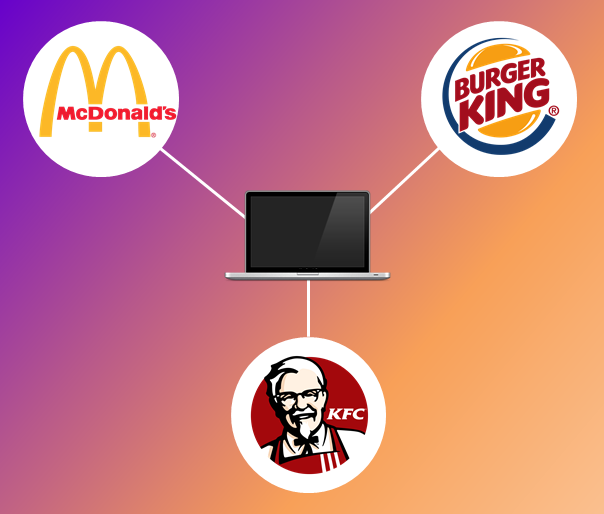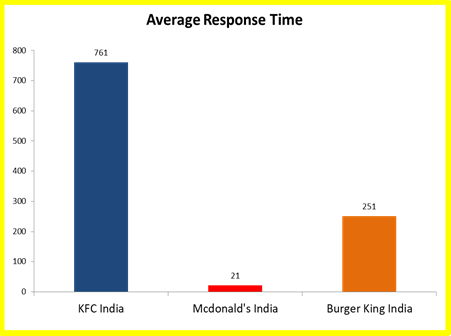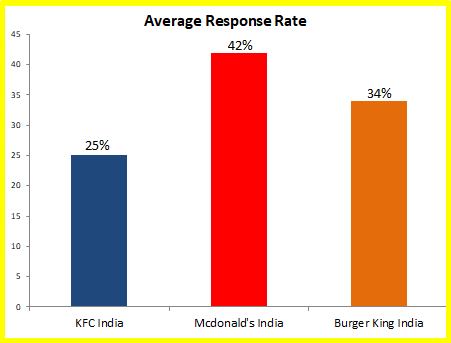
According to the NRAI Report, the quick service restaurant segment in India, valued at Rs.9,125 crore in 2016, is set to grow at a CAGR of 22% from 2016 to 2021. The majority of this flourishing segment is in metropolitan areas, with brands essentially vying for the same customers and cannibalizing each other’s sales.
The fierce competition brings into question, the brand’s “moments of truth” and their impact on customers. With the amount of people active on social media, online activity of a brand becomes an important touch point.
The recent Burger Emoji Debate showed us how creatively, KFC, McDonald’s and Burger King utilize their social media to create engaging content. However, who takes the cake, or in this case burger, when it comes to dealing with complaints?
The social media chatter ranges from deliveries, product quality, packaging and billing. To know which Indian burger chain delivers the best social media care, we studied recent customer conversations of these brands. Combined with Trooya’s Benchmarking, we present our findings about the brand which rules the roster when it comes to social media customer service.
Below are some crucial parameters to find out how well these chains are performing online customer care:
- Responses to customers on late delivery complaints: How does the brand react to customers who are upset with late delivery of order
- Responses to customers on wrong order delivery complaints: How does the brand react to customers who are saddened by wrong order delivery
- Average response time: What was the average time in which a brand issued a response to a customer
- Average response rate: How many customer interactions did a brand respond to, from the total interactions it received for a specific duration of time
Now, we’ll begin reviewing all brands on each of these parameters:
- Responses to customers on late delivery complaints:
Across their social channels, KFC India’s responses seem to be templated, when it comes to late delivery. They opt to take conversations offline. Nevertheless, the brand provides a link to their internal redressal mechanism on their website, which shields them from the view of netizens and can avoid a potential fiasco. On the other hand, this doesn’t instill confidence in the customer’s mind towards the redressal mechanism.
This shouldn’t have happened. Please share this on https://t.co/ckdbcbh6Yv, we want to get in touch with you.
— KFC India (@KFC_India) November 9, 2017
McDonald’s prefers to reduce the amount of web pages a customer has to go through to make their grievance heard. Instead of redirecting the user to their own website, they ask the user to privately send across the necessary details through the social media channel itself. In this case too, the customers are not able to see whether the brand was able to solve the problem or not.
Your delight is very important to us. Please DM us your Email ID, contact no. & store’s location & we’ll investigate.
— McDonald’s India (@mcdonaldsindia) August 10, 2017
Just as McDonald’s does, Burger King also opts to address their customer’s issues through the social media channel itself. Initially, the brand expresses regret for their customers’ long wait and then, asks them to DM the details for further assistance. However, the brand didn’t seem to have a lot of complaints on late delivery.
Hi Shravan, this should not have happened. Please DM us your order ID, contact & store location details. we will get in touch with you shortly.
— BurgerKingIndia (@burgerkingindia) November 22, 2017
KFC manages customers complaining about a wrong order in a manner similar to how they manage late order complaints. The brand seems to be too formal, without having a personalized tone since they don’t even mention the name of the customer in their responses.
This shouldn’t have happened. Please share this on https://t.co/ckdbcbh6Yv, we want to get in touch with you.
— KFC India (@KFC_India) November 9, 2017
McDonald’s responses are apologetic to their aggrieved customers and elicit more empathy as compared to other brands on social media. Being subtle and apologetic always helps to win the hearts of the disgruntled customers.
This shouldn’t have happened. Please share this on https://t.co/ckdbcbh6Yv, we want to get in touch with you.
— KFC India (@KFC_India) November 9, 2017
When we look at how Burger King manages wrong delivery complaints, their responses are personalized. They seek contact details and details of the branch where the order was placed via personal messages, in order to investigate and resolve a customer’s concern at the earliest.
Hi Shitij, this should not have happened. Please DM us your contact number and exact store location, so we can assist you better.
— BurgerKingIndia (@burgerkingindia) November 27, 2017
- Average Response Time:
Using Trooya’s Benchmarking tool, we derived the average time taken by these brands to respond to customers on Twitter.

Customers who complain on Twitter ideally expect a brand’s response within 30 minutes. However, only Mcdonald’s India is at par with the expected turnaround time, having clocked an average response time of 21 minutes. KFC India and Burger King India need to drastically work on their response time as they are 761 minutes and 251 minutes respectively.
- Average Response Rate:
Using Trooya’s Benchmarking tool, we derived the average response rate of these brands. Response Rate represents the number of customer interactions a brand has responded to, out of the total number of interactions present on their social media channels for a specific duration of time. Higher response rates are indicative of the brand attending to queries and concerns of most customers, if not all.

Mcdonald’s has a better response rate i.e. 42% in comparison to the other two burger chains. Burger King and KFC have a response rate of 34% and 25% respectively. As a higher response rate indicates most customer queries and concerns being covered, a higher response rate bodes well for a brand.
Based on our findings, we have given a weighted score to each parameter that is backed with reasons. This tabular format makes the comparison study of the listed brands easy to understand:
| KFC | Mcdonald’s | Burger King | |
|---|---|---|---|
| Responses for late order complaints | 4/5 | 5/5 | 3/5 |
| Reason: In the sample of responses we checked, 71% of late delivery concerns were responded to in a courteous and formal tone. There were few cases where the customer didn’t receive a response from the brand | Reason: In the sample of responses we checked, 92% of late delivery concerns were responded to, which reflects greatly on the brand | Reason: In the observed sample, only 43% of late delivery related concerns were responded to by the brand. Though the brand was observed to publish highly apologetic and personalized responses, they missed issuing responses to many complaints to them online | |
| Responses for wrong order complaints | 4/5 | 5/5 | 3/5 |
| Reason: In the sample of wrong order delivery related concerns we checked, 70% of them were responded to by the brand. | Reason: In the observed sample, 85% of the customer tweets were found to be responded to by the brand. | Reason: In the observed sample, only 48% of the concerns were responded to by the brand. While brand responses seemed empathetic, personalized, they also seemed templated in certain cases. Few cases were also observed, which weren’t responded to by the brand | |
| Average Response Time (Minutes) | 1/5 | 5/5 | 3/5 |
| Reason: Their turnaround time is at a staggering 761 minutes | Reason: They have a great turnaround time of 21 minutes | Reason: Their turnaround time is 251 minutes | |
| Average Response Rate (%) | 2/5 | 3/5 | 2/5 |
| Reason: 25% is indicative of having a need to respond to more customer posts | Reason: 42% response rate indicates that the brand has scope of improvement | Reason: 34% is a sign that the brand needs to buck up on social media customer service | |
| Average weighted score | 2.6 | 4.8 | 2.9 |
Note: The observed sample mentions were taken from past 6 months.
Following are the takeaways derived from our findings:
- Quick response time is critical: Response times are considered an important metric to judge the performance of brands online. In an age where brands face heavy competition online, it isn’t wise to create a disgruntled customer due to a late brand response. Efforts must be taken to ensure that response times are restricted to within an hour, at least for those customers who interact with a brand during its working hours.
- Personalization is the whole idea: Few brands realize the importance of personalizing the responses. It is a key to win hearts of your customers who are aggrieved and dissatisfied. Personalization of responses helps in ‘conversing’ rather than just ‘responding’ to customers. Customers will keep coming back as long as they feel they are being heard
- Try to resolve the issue on social media: Customers approach brands online because they want to talk online only. Thus, redirecting them to another microsite or forum for seeking assistance defeats the purpose of having an online presence. This means that brands should try to interact and resolve a customer’s queries online and only redirect when it is necessary.
Hope these learnings help your brand to enhance social media customer service!
For more such researched pieces, kindly subscribe to our blog.
